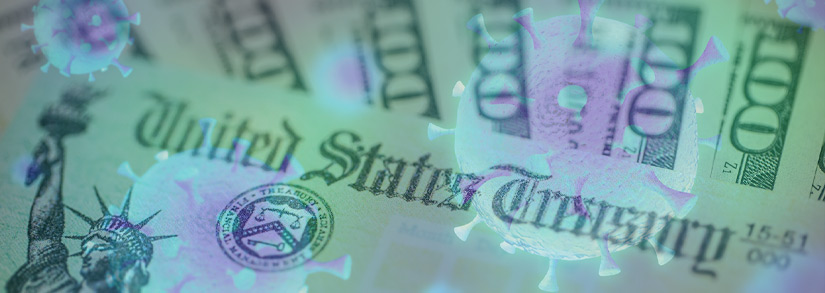
- Issuance of U.S. asset-backed securities was down 25% year over year in 2020 due to the pandemic, but its influence was uneven — with the impact highest on ABS tied to credit cards, travel, entertainment and retail.
- The performance of consumer ABS was resilient across the board in 2020, due to the effectiveness of the stimulus and borrower-relief programs.
- For the short term, borrowers’ ability to repay may hinge on the continuation of these relief programs. Long-term consumer-ABS performance may depend on the economy’s post-pandemic recovery.
Issuance of U.S. asset-backed securities (ABS) fell by 25% in 2020 from the previous year, as credit tightened during the COVID-19 economic crisis. The performance of loans underpinning various types of ABS proved resilient, however, as economic-relief packages helped support U.S. consumers. In the coming months, consumer-ABS performance may depend on continued government support and economic recovery.
Issuance amid Pandemic
The impact on ABS issuance was uneven across market segments: Among the three major areas of consumer ABS, credit card ABS were most affected; ABS related to travel, entertainment and retail also felt the impact on issuance.
COVID’s Uneven Impact on ABS Issuance
Source: Intex
Relief Programs Helped Loan Performance During the COVID Shock
The credit performance for the existing loans in consumer ABS was surprisingly resilient, despite the severe economic shock caused by the pandemic. In fact, delinquency and default rates were much lower than during the economic stress of the previous decade — likely due to the timely and broad consumer-relief programs established by the government and lenders in response to the 2008 global financial crisis.
Auto-loan ABS’s delinquency and default rates generally improved after COVID spread in the U.S., as real disposable income increased per capita when the government’s stimulus checks and unemployment benefits began to reach households in April.1 As the financial support tapered off, however, delinquencies once again rose from historically low levels. Another driver of the delinquency drop could be debt-relief programs offered by lenders, including deferral, forbearance and loan extensions. These loan actions temporarily kept auto loans from default, but potentially make them more vulnerable once those programs expire, since borrowers might face a higher loan balance afterward.
Performance of Auto-Loan ABS Generally Improved After the Outbreak
Source: Intex, Federal Reserve Bank of St. Louis
Recovery rates for auto-loan ABS also improved — except in April, when used-vehicle sales paused due to strict lockdowns. As transactions resumed in summer, recovery rates returned to normal levels. Recovery further improved as used-vehicle prices soared in August, and remained elevated till the end of the year.2
Recovery Rates in Auto-Loan ABS Improved as Lockdowns Eased
Source: Intex, Federal Reserve Bank of St. Louis
Amid Tighter Credit and Lower ABS Issuance, Healthy Performance of Credit-Card Loans
While issuance of credit-card ABS fell sharply in 2020, as lenders tightened credit,3 the charge-off and principal-payment rates held up well. The exhibit below shows this data for issuers of general-purpose-credit-card ABS and private-label issuers. At the onset of the U.S. COVID pandemic, card transactions slowed down and the charge-off rate dropped.4 The principal-payment rate was slightly down in the second quarter, but returned to normal or a slightly elevated level, thanks to improved disposable income and lower credit-card spending. Given credit cards’ high interest rates, our ABS model assumes that borrowers tend to make paying down card debt a priority when they receive stimulus payments.
Improved Charge-Off and Principal-Payment Rates for Card ABS
Source: Intex, Federal Reserve Bank of St. Louis
Student-Loan ABS Benefited from Forbearance Program and Other Policies
For both federal-student-loan ABS and private-student-loan ABS, default rates dropped to half their pre-pandemic level. In addition to the stimulus checks and unemployment benefits, support came from lenders’ COVID forbearance policy, led by the U.S. Education Department, which granted a forbearance period (with no interest accrued) till September 2020, before it was extended to Jan. 31, 2021. The relief policy helped borrowers stay current with their student debt and created a six-month bump in forbearance for student-loan ABS. As forbearance returned to an only slightly elevated level, we observed a rise in deferment, indicating that certain borrowers are still seeking ways of pushing back their repayments. If current policies supporting student-loan borrowers (forbearance and stimulus checks) expire, debtors may not prioritize repayment of their student loans.
As Student-Loan Forbearance and Deferment Rose, Default Rates Dropped
Source: Intex
Healthier ABS Markets Still Vulnerable to COVID-19’s Course
Even as the vaccines roll out, the COVID-19 pandemic is still raging and consumer-ABS investors face a key risk factor: the continuation of the borrower-relief programs. The Biden administration and Congress will likely keep the stimulus checks coming. In the long term, however, consumer-ABS performance still depends on a post-pandemic economic recovery.
1“Real Disposable Personal Income.” Federal Reserve Bank of St. Louis.
2“Consumer Price Index for All Urban Consumers: Used Cars and Trucks in U.S. City Average.” Federal Reserve Bank of St. Louis.
3“Consumer Loans: Credit Cards and Other Revolving Plans, All Commercial Banks.” Federal Reserve Bank of St. Louis.
4Ibid.
Further Reading
Can MBS Duration Turn Negative?
Are Securitized Products Ready for the LIBOR-SOFR Transition?
Consumer ABS: Recovering from Coronavirus?
Consumer ABS Under Coronavirus in the US and China
MSCI US Auto Loan Collateral Model (client access only)
MSCI US Credit Card ABS Collateral Model (client access only)
